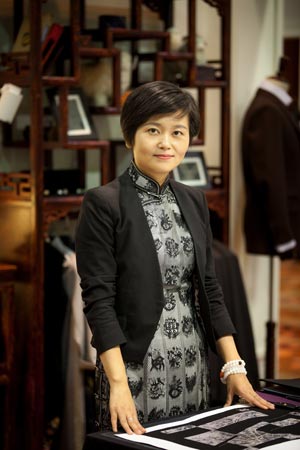Grand design
Updated: 2014-08-12 08:16
By Zhao Xu in Beijing and Zhang Chunyan in London (China Daily)
|
||||||||
"China may have a thousand universities that offer art and design education, but the number of those at the top of the pile is in single digits. For a long time, students and their parents have fallen over one another in the scramble to reach the top before realizing there is an alternative route."
|
 Zuo Wen is a fashion designer who graduated from the London College of Fashion. PROVIDED TO CHINA DAILY
Home style It was a bow on a dress that finally undid everything for Zuo Wen, when she wondered whether she really wanted to continue designing and making clothes for women. "When I first returned to China in 2006, I did couture for ladies," said Zuo, 34, a fashion designer who graduated from the University of the Arts London. "But then I was soon brought to face situations in which I had to choose between being a good designer and being one who simply pandered to people," Zuo said, recalling a customer with a bow fetish who insisted that Zuo add a giant bow to an elegant, minimal dress she had designed. "Saccharine beauty did not work for a woman of her age. But she insisted. The end result was that she was happy, but I was not. That's when I decided to chop that part off my business portfolio. "Emotionally and perhaps financially in the long term, I cannot afford to lose my credentials as a couture designer." Li Yizhou, an industrial designer in Beijing who has studied overseas, said Zuo's case is typical of a new generation of Chinese designers who have trained abroad before returning to jump-start their careers. "In terms of design and the West, China is in a different time zone. That means designers who want to make it here must be fully aware of the pitfalls of the Chinese market. They must ensure their ambitions are realistic." Another important thing is cost, Li said. "The Chinese are quickly catching up in their appreciation of fashion and design, but that does not mean they are as willing as Westerners to pay a premium for it. For a designer to succeed in China, he or she must have a deep understanding of cost control." Jonathan Kearney, director of Camberwell College of Arts in London, said: "Nearly all Chinese students return to China because getting a job here is very, very difficult," he said. Jiang Qiong'er, 37, is a well-known designer and entrepreneur who has teamed up with the French fashion house Hermes to launch what has been touted as China's first luxury fashion brand, Shang Xia. Commenting on the popular concerns that the sheer number of overseas-educated designers is beginning to dilute their value, Jiang said there is still good reason to study abroad, although that purpose should be vastly different to the one her generation of Chinese designers had. "When I enrolled myself at the prestigious Ecole nationale superieure des Arts Decoratifs in Paris more than 10 years ago, China was still an island of its own in terms of design. With previous experience of Western designs, I went there to study, and also to experience for myself, everything related to the concept of design - from daily products to emotionally charged spaces. "A good design is rooted in deliberation, which in turn demands time, while in China, everything seems to happen in a minute. More than anything else, I wish our young design students would bring this attitude back home." Zhao Xu in Beijingand Zhang Chunyan in London |
In some Western countries, including Britain, education has been commercialized for decades, with tuition fees from foreign students being an important source of revenue for universities and training colleges.
This has long left schools open to the claim that making money has become their main priority. The current rise in the number of Chinese students in top art and design colleges in Britain and the US has only served to reinforce this claim.
"There's a feeling that top British art schools have become the latest bastion to be breached by the all-powerful 'Beijing pound'," said Tan, whose tuition fee at the Royal College of Art is 27,900 pounds ($47,000) a year, compared with the yearly 10,000 pounds charged for international students by an average non-art college in the country.
"The undergraduates are generally required to pay more. And this does not include the high living expenses, as well as the other expenditure often entailed by the study of art and design, the buying of materials for example."
Jo Ortmans, head of external relations at the University of the Arts London, said school authorities welcome the change in enrollment.
"We are seeking to maintain the current levels of Chinese students as we have strong demand and high-quality applicants from both the Chinese mainland and Hong Kong, especially at the undergraduate level. International students make up 35 percent of the student body and within that group, Chinese students are currently around 30 percent," she said.
"There are no disadvantages to having Chinese students at the university. ... They add to the diverse and exciting mix of the creative culture here."
But not everyone is convinced. "Young Chinese going abroad to study art and design fall into two categories: those who know what they want and those who don't," said Li Yizhou, 30, a fellow Tsinghua alumnus of Tan.
"Most of the first group have been in art and design, either for personal or family reasons. Many in the second group have scant previous contact with the field. And some choose to study it simply because the bar is not as high as, say, the one set for scientific and literary subjects. Or at least that is the common perception."
Helping hand
In a recent CNN news report, some Chinese recruiting agencies were accused of cheating to get their clients into foreign universities.
Que himself acknowledged that he has hired "a team of art and design professionals" to do "tutorial or consultative sessions" with the company's student clients, but he sees the nature of his business differently.
"An art/design student's application is built around what is called their portfolio, a collection of works showcasing the applicant's creativity. Chinese students do not lack in creativity; what they do lack is the ability to conceptualize their works, to simultaneously show the uniqueness and interrelatedness of each of the works," he said.
"And in that, we have a vast pool of professionals on hand to help, including some in leading foreign art and design institutions who have first-hand knowledge about how to make a portfolio stand out and impress."
If a client, usually a younger one, needs prolonged and intensive coaching, the cost starts at about 50,000 yuan ($8,100), and it could easily reach 250,000 yuan.
"In rare cases, we charge up to 450,000 yuan for more comprehensive services including flying our clients to Europe and the US for long-term one-to-one sessions with a highly regarded artist/designer in the field, or arranging for their internship with leading design firms who act as our local partners. It's fair to say that we don't just help with the portfolio, for those who can afford it. We help with the development of a client's genius before it can be seen by the university he or she is aiming for."
One of the foreign coaches is Evan Douglis, dean of the School of Architecture at Rensselaer Polytechnic Institute, in New York state. Douglis said he coaches applicants on "how to present the idea behind the picture".
"(Other than Chinese) we don't offer similar help to other students."
There is no doubt that in the West, particularly in recent years, studying art and design has become extremely expensive, and something that the rich can well afford.
"Many parents tell me that by funding their children's overseas education in art and design, all they want for their next generation is happiness," said Wang of Share With You.
"This totally relaxed attitude, slightly offensive to middle-class sensibilities, I guess, points to the immense wealth this privileged group commands."
Que agreed. "Let's face it: If wealth makes a difference in people's lives, then this difference becomes more amplified nowhere else than in education. These students may have become the objects of envy, but believe me, it's just the start."
Zhou Heran contributed to this story.
Contact the writers at zhaoxu@chinadaily.com.cn
Most Viewed
Editor's Picks

|

|

|

|

|

|
Today's Top News
Many Chinese economic fugitives still at large in US
Chinese medical supplies arrive in Ebola-affected Sierra Leone
China's Huawei shows interest in LatAm
Kerry: Formation of Iraqi govt critical for stability
Shooting leaves 2 dead, 5 injured in New Orleans
Police focus on emigrants who still have their hukou
Chinese Ebola doctors leave for Africa
At least 39 killed in Tehran jet crash
US Weekly

|

|
















